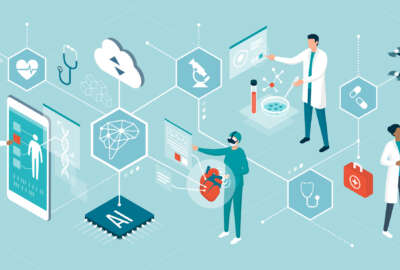Hubbard Radio Washington DC, LLC. All rights reserved. This website is not intended for users located within the European Economic Area.
HHS launches its promised health innovation network
The Advanced Research Projects Agency for Health has proceeded with its promised network of health innovation sites. Anchoring the network are three regional hu...
The Advanced Research Projects Agency for Health has proceeded with its promised network of health innovation sites. Anchoring the network are three regional hubs also planned at the inception of ARPA-H. For what they hope for the network, Federal Drive with Tom Temin talked with the Director of the agency’s Project Accelerator Transition Innovation office, Craig Gravitz.
Interview Transcript:
Tom Temin Okay. Lots of questions here. These three regional hubs and a network of other institutions connected. What are you doing here? You’re not just creating a lot of bureaucracy and cost, are you?
Craig Gravitz Absolutely not. So to really understand what we’re doing, you have to understand my function at the agency. So I’m the director of transition. I’ve worked in government R&D for many, many years. And one of the risks is that we create these wonderful technological solutions and they sit on the shelf. So the way that you make sure that these technological solutions actually get to people and help people is by understanding what your transition pathway is. And fundamentally, this network is about creating these transition pathways to take it from the lab to the human.
Tom Temin We like to say you’re bridging the valley of death with a superstructure.
Craig Gravitz Yeah, for sure. So that’s my function in the in the agency is to really come up with a transition strategy for our programs at scale. So I’m very motivated and influenced by human centered design. And there’s this concept that was popularized by the design firm IDEO and it’s all about how innovation happens. Picture a Venn diagram. So there is feasibility. That’s the technical innovations themselves. So think about all the things that our program managers will do at ARPA-H. That’s technical feasibility. But in order to get things out into the real world, you need to really think about two other pieces. One is desirability. So that’s people, the wants and needs of actual human beings who your customers are. Think about issues like trust, affordability, understanding, being able to communicate to people what you’re doing. That’s desirability. And then the other element is viability. Markets, you know, we’re creating technological innovations that are going to have to live somewhere. You know, what are the markets have to say about that? What is the regulatory strategy? How do you make a solution that fits with the current FDA paradigm? How does it get reimbursed through CMS? And so my theory is that you really need to get at the bull’s eye of those three elements feasibility, the technology, desirability, the people and viability of the markets and these hubs. They roughly correspond to those three things.
Tom Temin These hubs are located where.
Craig Gravitz So our viability or our market investor hub that’s located in Boston, our desirability or our customer experience hub that’s located in Dallas and right now loosely affiliated with this effort, but not necessarily part of it will be our stakeholder and operations hub that will be located somewhere in the Washington, D.C. area. Wasn’t part of the original competition that we did.
Tom Temin Plus, you have a list of several other institutions that are part of the innovation network, you might call it.
Craig Gravitz Yes, that’s the most important part of this. And really what I hope your listeners will take out of this is that if our page is really going to solve for all Americans, which is our mission, we’d need to be across all of America. And so it’s less about the hubs themselves and more about the networks that they create. So, for instance, we have our Investor Catalyst hub in Boston. One of the requirements of the competition was not just, yeah, they have these amazing capabilities in Boston and they do. It’s that they have the ability to reach all across the country and to similarly situated institutions in rural areas and urban areas all across from the from the East Coast to the West Coast, everything in between. The idea is that markets aren’t just in Boston, they’re all across the country. And the same thing with our Customer Experience Hub that’s based out of Dallas. There are human beings with different wants, needs, desires, hopes and dreams all across the country. And so it’s not addressed by the site. It’s about their reach, the depth and breadth of their network all across the country.
Tom Temin And these hubs then consist of several groups that got together and made a bid to ARPA-H to become a hub.
Craig Gravitz Absolutely. And then what’s really exciting is that we used other transaction authority to do this. So we have a very flexible strategy where we can bring on additional spokes. If you think about it as a hub and spoke network with every effort that we do, we have the ability to bring on different types of institutions. And I’ll give you a for instance, right now, through our Customer Experience network, we’re doing a project accelerating clinical trial readiness, otherwise known as ACTR. And really, that’s all about making sure that clinical trials are more accessible to people all across the country. We’re doing what’s called a network activation call right now where that brings in basically a 360 degree view of all the types of institutions that are involved with clinical trials. And so new spokes, we’re recruiting them right now. It would be unreasonable. To think that with the original call, we could have thought about every possible permutation of every effort that we do inside our page. And so with each effort that we do, we’ll bring in new spokes so that we’re able to be all across the country.
Tom Temin We’re speaking with Craig Gravitz. He’s director of the Accelerator Transition Innovation Office at the Advanced Research Projects Agency for Health, part of HHS. Well, maybe just walk us through the journey map of what happens if somewhere someone out there develops, you know, the artificial kidney that you can strap on your belt, you know, and do away with dialysis. I mean, I’m making this up, but I know that happens to be one of HHS’s off again on again types of endeavors and it’s feasible. Then what? How would this get across that valley of death using this network of networks that you’ve described?
Craig Gravitz So I can’t speak to that technology specifically, but I will sort of loosely voice track the journey map. So imagine a program managers. Everything at ARPA-H is driven by a program manager expert in his or her field. They will take one of these efforts like the one you described, and they’ll be working in their program to unblock the different technical milestones to do that. So with the, you know, an artificial kidney, it could be getting the belt. It could be building the kidney. All of those other things that individual be working through that. Now, in parallel, my team helps to figure out all of the other risks to getting it out into the real world. So there are obviously going to be FDA considerations for this. How do you make sure that there is an appropriate regulatory approval path for that to happen? And so we’ll be working closely with FDA to, you know, understand, you know, whether this comports with the things that they require for things to be safe and effective. We also need to be thinking through how this would be reimbursed with CMS or through other payers. And so what my team does is we help in parallel to the science, de-risk all of these other things. We also have to think through what the business models will be for this. And so think about one pathway, the CX network will be thinking about, okay, that sounds really great, that that artificial kidney, what actual people think of that. Would that be scary to them? Is that something as we’re starting to roll this out, is there even a market for that? There’s things that, from a scientific perspective, sounds amazing, but when you actually get to humans, there are real roadblocks to doing that. They might not trust the solution or candidly, a lot of reasons why products fail. Are these sort of basic user design things like the product itself might work, but it could be uncomfortable, it could be painful, it could be expensive. And so we need to make sure while the science is being developed, we’re thinking through all of these other considerations. And so if you think about it, a path in parallel to all of these technical milestones, what my team does, especially through these networks, is we de-risk all of these other elements so that when you get to the finish line, there’s not only a market for it in terms of people who enthusiastically want to adopt it. There’s also a business model associated with a company that will be able to sell it in the marketplace and be able to provide it at a at a reasonable price to human beings, not just for the wealthy, but for all of us, people like you and me.
Tom Temin And this sounds like a lot to orchestrate. And is that basically what your office does in Washington is to make sure all these parts mesh while they’re moving towards the eventual commercialization here?
Craig Gravitz Yes. So previously, before coming to ARPA-H, I worked in research and development, the Defense Department. And so one of the things that DoD research has, especially DARPA, wasn’t that DARPA, but this is true broadly for any R&D that happens at the Defense Department is that you de-risk that technical milestone and the follow on funder is some entity inside DoD. The main difference, aside from the mission set between DARPA and ARPA-H, is that we don’t have the DoD to be that follow on funder to create that pull through. The reason why my office exists is to sort of reverse engineer that, pull through, make sure that there’s someone willing to adopt it. So one of my favorite stories about DARPA, if you think back to stealth technology, the program manager who developed that had, you know, two gentlemen from the Air Force right there, and there’s the original test flight. And that moment is what really made the Air Force interested in funding stealth because they saw that it was true. Wow. This technical milestone truly has been unlocked at ARPA-H we don’t have the same ability to grab two gentlemen who control the purse strings. You know, we have to find some other way to make our version of stealth survive in the wild. So yes, it is a lot to orchestrate to create these networks. However, if we want to actually succeed and build these technologies to actually get used and enthusiastically adopt by, you know, all Americans, we need to make sure that there is that follow on funder.
Tom Temin Anything in the pipeline right now that looks promising.
Craig Gravitz Yeah. So you could go on our website and you can take a look at some of the initial programs that we have launched. We have, you know, a number of, you know, open calls and things that are being in evaluation right now. But you can. Look at all of those things right now. Two of them that come to mind, which are really exciting, is our NITRO program is developed by Dr. Ross Uhrich. This is what if joints could heal themselves. So think about osteoarthritis and all the problems that that creates for mobility and the obesity that comes from not being able to move around in pain. Well, what if you could do something so that instead of having to go to surgery to replace something, you just get a shot? And so if this succeeds, we could use this network to, you know, potentially reduce manufacturing costs, or we could do user acceptance testing in terms of like the concept, Is this scary? Is there some way that we can, you know, present this in a way that people understand what it is? So that one’s really exciting and then we have a number of them, but just another one that that comes to mind is Precision Surgical Interventions launched by Dr.Ileana Hancu. This is all about getting rid of all the cancer in your body when you have cancer instead of, you know, the current state of the art, which is get rid of what you can see and then just hope it doesn’t come back. You know, her concept is what if you can get rid of all of it in one shot?
Tom Temin Wow. So sounds like some exciting things going on. And now the network has stood up. Next steps are what?
Craig Gravitz So right now we’re onboarding a number of spokes. So as I mentioned earlier in the interview, we really need to be solving for all Americans and being everywhere. And so we’re just trying to recruit all different types of institutions, both traditional, you know, fund seeking entities, you know, the types of folks who respond to calls for proposals, but also nontraditional entities like community health centers, hospital systems, other experts. And we’re deep into recruiting all of those spokes right now because we recognize this network will only work if we have just a broad range of players, both traditional and nontraditional.
Copyright © 2024 Federal News Network. All rights reserved. This website is not intended for users located within the European Economic Area.
Tom Temin
Tom Temin is host of the Federal Drive and has been providing insight on federal technology and management issues for more than 30 years.
Follow @tteminWFED
Related Stories
New HHS research agency embarks on mission to tackle far-reaching health problems
Related Topics





